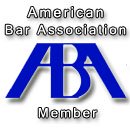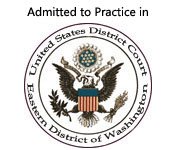Ask an Attorney a Question for FREE!
The Police Report Overlay Sheet
This sheet will help you understand any police report
To understand the report, you first need an overlay sheet. Every state has one, but every locality or jurisdiction can change the way they write the reports.
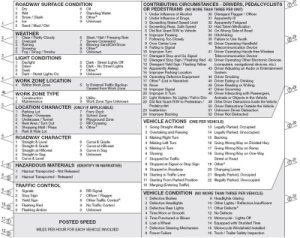
Below you will find a list of the most common overlay sheets in the United States. Click here for a list of overlay report sheets for all states.
Once you obtain a copy of the report, and before you fax it to your claim adjuster, you must be able to understand exactly what the report says.
In the following example, there is no indication of fault, or other circumstances that could have contributed to the accident. However, the codes on both sides of the report will tell a different story.
How do you know what these codes mean? You should look at the overlay sheets to find out. The problem is that most states do not provide them. You must ask for them!
The Overlay Sheet is used to interpret the codes written on the Police Traffic Collision Report.
You are supposed to place the Overlay Sheet on top of the report making the numbers on both sides match. You can compare the codes with its corresponding meaning, noted at the overlay sheet, for Driver 1 and Driver 2 (and/or Driver 3).
Here is the Washington State Overlay Sheet to interpret any accident reported by the state patrol:
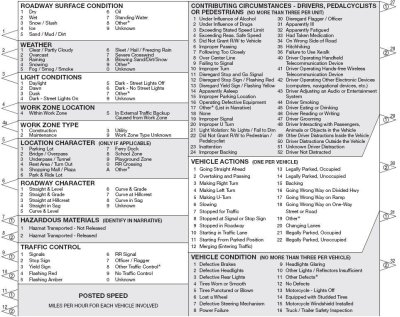
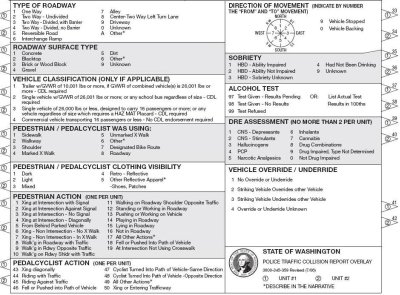
Once you have the overlay sheet, interpreting your report is not much of problem. Here, I will go over the process. The first section on the police report looks like this:
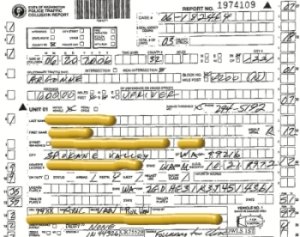
The first part of the Washington Overlay shows that box 1 (on the left side) explains the road conditions. In this case, the police officer has just to check a line across, not making any notes regarding the road conditions.
The right side of the police report has three boxes that repeat themselves. They are numbered 1, 2, and 3. They repeat themselves in different categories. These numbers are to the left of the boxes.
They represent the unit or vehicle number noted in the actual report. The number to the right of the box represents the category noted in the Overlay Sheet.
These very first boxes on the right side of the report correspond to categories 27, 28, and 29 on the overlay sheet. They outline the contributory circumstances of the accident.
This category is essential in determining fault in any accident. Here is where you find out what people did wrong according to the police. In this case, unit 1 has been tagged with the number 7.
In the overlay sheet Category 27, number 7, corresponds to “following too close”. Category 28, number 18, corresponds to none.
Finally Category 29, number 01, corresponds to Under the Influence of Alcohol!
So, the driver of Unit One was under the influence of alcohol! You will not see anywhere on this police report anything regarding this. So if you do not know how to read a police report, you will not be able to use this to your advantage.
Note, there was no citation for DUI, but the police still believe that alcohol was a factor.
You can continue down reading the entire report on both sides, per unit number, and see what the police actually wrote about the accident.
Page 2 of the police report looks like this:
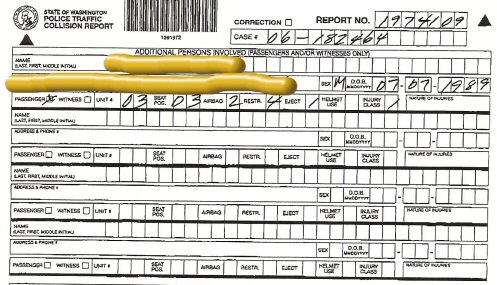
The first section lists all passengers and witnesses. If your passenger is not listed here, then the insurance company will be asking why this person is not on the police report.
Consequently, if a witness is not listed, then the insurance company can dismiss their statement altogether as “they were not at the accident scene”. Therefore, they are not witnesses.
The narrative of the police reads:
“All 3 vehicles were north bound on Argonne. Units 2 and 3 were stopped for traffic backed up for a red light. Unit 1 one did not stop on time then rear ended unit 2, which rear ended unit 3.”
The police make statements on who hit who, but the details of the accident are all missing. There is no indication of alcohol, drugs, or medications. However, we know that the contributory circumstances unit one had were alcohol charges.
This is why you need to learn how to read your police report. The following links can help you get the overlay sheet of all states (note that some overlay sheets are contained within the police report itself).
Bodily Injury eBook
Traffic ticket eBook
Total Loss eBook
1. Recorded Statement
2. Police Report
3. Overlay Sheet (Interpretation of Police Reports)
4. Accident Photos
5. Accident Diagrams
6. Accident Videos
7. Vehicle Damage Estimate
8. Length of Time of the Auto Insurance Claim
Find a Qualified Attorney in Your City
|
For a Free Review of Your Case
Please Call (866) 878-2432 |
